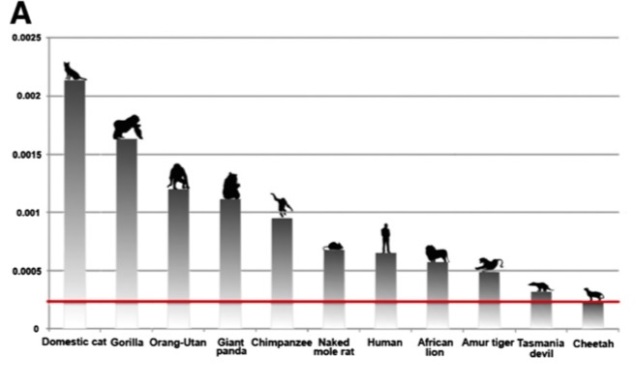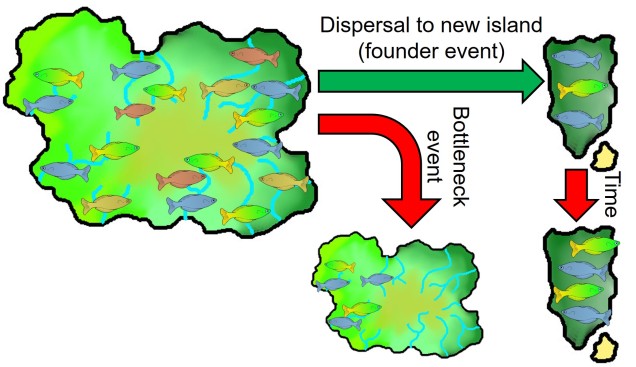Demographic history
Many things in life are the product of their history, and nothing exemplifies this better than evolution. Given the often-gradual nature of evolution by natural selection, environmental stressors and factors operating on long-term scales (i.e. over thousands or millions of years) can have major impacts on evolutionary changes across the diversity of biota. While many of these are specific to the characteristics of the target organism (i.e. are related to adaptive traits), non-adaptive (neutral) traits are also critically important in driving the path of evolution.
One of the main areas of ‘non-adaptive’ characteristics that we might choose to investigate is demography: that is, the size, structure and composition of population cohorts. These are considered non-adaptive since they don’t necessarily relate directly to any particular trait under direct natural selection, although of course they are keenly intertwined. Particularly, population size is a strong factor in the long-term stability and evolution of species and populations as larger populations often hold greater diversity in their genotypes and phenotypes than smaller ones, thus providing greater adaptive potential.

Because of the relationship between population sizes and adaptive potential, understanding the history of demographic changes across space and time is important to unveil the full nuanced overview of a species’ evolution.
The impact of population size and structure
For many species, significant decreases in population sizes associated with major climatic changes in the past (such as the glacial cycles of the Pleistocene) have been detected through genetic-based studies. The reduced available habitat suitable for a large number of contemporary species – particularly those adapted to specific ecosystem-types or thermally restricted – caused populations to shrink with the greater competition for resources. These smaller habitats (dubbed ‘glacial refugia’) were also largely isolated from one another, creating a series of disjunct islands of suitable areas. The impacts of these refugia varies among taxa, depending on their dependency on environment and a plethora of other biological characteristics, but commonly lead to the formation of highly structured genetic variation throughout species ranges. For some taxa, this fragmentation likely led to the formation of new species as individual refugia evolved independently of one another throughout their periods of isolation.
Let’s take a look at some other broad theoretical (and empirical) impacts of demographic history on the sustainability and evolution of species.
Genetic bottlenecks
Strong reductions in the size of populations can have profound impacts on the longevity of species through what is referred as a ‘bottleneck effect’. Sudden and extreme reductions in the number of individuals within a population purges much of the genetic variation with it, causing the total gene pool (i.e. the number of genetic variants throughout the population) to similarly dramatically decrease. Even in relatively minor bottleneck events, this can lead to removal of adaptive alleles which reduces the adaptive potential of the population.

In extreme bottleneck events, populations can become so small that only handfuls of individuals remain. At this level, inbreeding becomes a serious issue as the lack of unrelated individuals forces them to breed with relatives. Naturally, this has significant consequences on the resultant offspring due to their massively reduced internal genetic diversity. Without the genetic diversity for future (or current) adaptation, the population is subject to what we call ‘inbreeding depression’.
For an example of the impact of a major bottleneck event, we can have to look no further than an iconic big cat: the cheetah. Believe it or not, the ancestor of the cheetah was once found as far across the globe as the Americas (the nearest living relatives to the cheetah are puma) and across to Asia. However, the changing climates of the Pleistocene caused most populations of the cheetah to go extinct, reducing its distribution to Africa and west Asia. This huge sweeping removal of individuals – exacerbated, of course, by more recent human impacts – severely reduced the total genetic diversity of the cheetah. In fact, individual cheetah are almost clonal, with less genetic variation between individuals than Tasmanian devils (which are so inbred that their facial cancer is transmissible because the immune system of one devil doesn’t recognise the introduced cancer as foreign). Likewise, in cheetah, transplants of skin and organs could be performed across individuals without organ rejection due to the lack of differentiation between them.

While bottleneck effect might not always reduce genetic diversity to this extreme, the broad reduction in available diversity for adaptation can frequently impact the longevity of populations over time.

Founder effect
Inversely, new populations that have been founded from a relatively small number of individuals may also experience a type of genetic bottleneck. In this circumstance, we refer to this phenomenon as ‘founder effect’, which occurs when a new population is founded with extremely low genetic diversity owing to few original individuals. Particularly, founder effect is an important aspect of understanding phylogeographic patterns of dispersal, as colonisation of new habitats often results in the genetic signature of a strong bottleneck event followed by population expansion within the new environment (if the founding was successful).

…or not?
However, not all founding populations seem to suffer to the same degree from the lack of diversity. The most key examples of these are invasive species: often brought into new environments (even continents) by human settlement, initial founding populations of invasive species are likely critically low at colonisation. So how do they manage to not only adapt to a new environment, but proliferate and spread? What traits are key for invasiveness?
Recent research into some invasive species have indicated that while certain ecological traits play a strong role in the ability of certain species to become invasive (such as reproductive ability, flexibility in diet or growth rate), other genetic traits are important too. Particularly, the ability to derive new physiological traits from the same underlying genotype (phenotypic plasticity) is important for rapid adaptation to newly invaded environments. Similarity between the invaded and original host environmental of the pest also seems important in determining ‘pre-adaptation’ to the new conditions.
The impact of history
The various aspects of demographic history have profound implications for the long-term evolution and survivability of population and species, and historical impacts of past bottleneck events may pre-dispose some species to be more sensitive to future selective pressures. In this sense, understanding which taxa are most at risk under future and current climate change as a result of their long-standing reduced genetic diversity is a key component in predicting those that may be able to adapt and those that are likely to go extinct in the near future, allowing us to provide more targeted and effective conservation management.

3 thoughts on “Products of their time: the impact of demographic history on evolution”